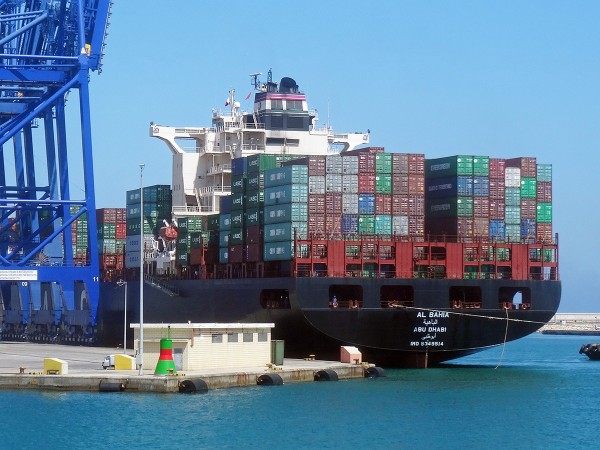 The International Monetary Fund has just published its six-monthly World Economic Outlook (WEO). The publication assesses the state of the global economy and forecasts economic growth and other indicators over the next few years. So what is this latest edition predicting?
The International Monetary Fund has just published its six-monthly World Economic Outlook (WEO). The publication assesses the state of the global economy and forecasts economic growth and other indicators over the next few years. So what is this latest edition predicting?
Well, once again the IMF had to adjust its global economic growth forecasts down from those made six months ago, which in turn were lower than those made a year ago. As Larry Elliott comments in the Guardian article linked below:
Every year, economists at the fund predict that recovery is about to move up a gear, and every year they are disappointed. The IMF has over-estimated global growth by one percentage point a year on average for the past four years.
In this latest edition, the IMF is predicting that growth in 2015 will be slightly higher in developed countries than in 2014 (2.0% compared with 1.8%), but will continue to slow for the fifth year in emerging market and developing countries (4.0% in 2015 compared with 4.6% in 2014 and 7.5% in 2010).
In an environment of declining commodity prices, reduced capital flows to emerging markets and pressure on their currencies, and increasing financial market volatility, downside risks to the outlook have risen, particularly for emerging market and developing economies.
So what is the cause of this sluggish growth in developed countries and lower growth in developing countries? Is lower long-term growth the new norm? Or is this a cyclical effect – albeit protracted – with the world economy set to resume its pre-financial-crisis growth rates eventually?
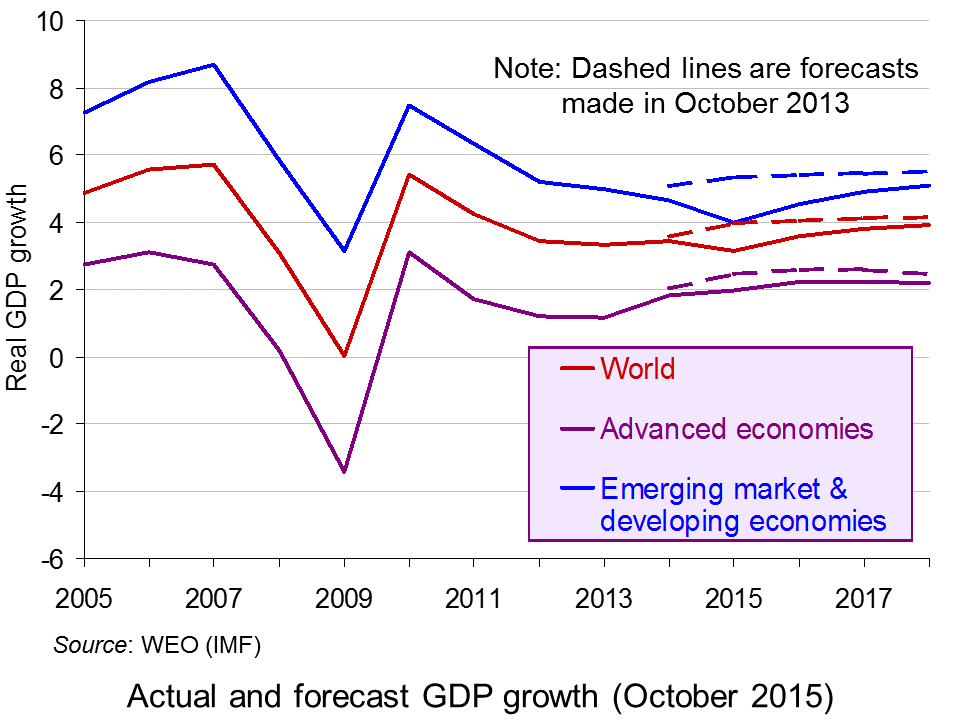 To achieve faster economic growth in the longer term, potential national output must grow more rapidly. This can be achieved by a combination of more rapid technological progress and higher investment in both physical and human capital. But in the short term, aggregate demand must expand sufficiently rapidly. Higher short-term growth will encourage higher investment, which in turn will encourage faster growth in potential national output.
To achieve faster economic growth in the longer term, potential national output must grow more rapidly. This can be achieved by a combination of more rapid technological progress and higher investment in both physical and human capital. But in the short term, aggregate demand must expand sufficiently rapidly. Higher short-term growth will encourage higher investment, which in turn will encourage faster growth in potential national output.
But aggregate demand remains subdued. Many countries are battling to cut budget deficits, and lending to the private sector is being constrained by banks still seeking to repair their balance sheets. Slowing growth in China and other emerging economies is dampening demand for raw materials and this is impacting on primary exporting countries, which are faced with lower exports and lower commodity prices.
Quantitative easing and rock bottom interest rates have helped somewhat to offset these adverse effects on aggregate demand, but as the USA and UK come closer to raising interest rates, so this could dampen global demand further and cause capital to flow from developing countries to the USA in search of higher interest rates. This will put downward pressure on developing countries’ exchange rates, which, while making their exports more competitive, will make it harder for them to finance dollar-denominated debt.
As we have seen, long-term growth depends on growth in potential output, but productivity growth has been slower since the financial crisis. As the Foreword to the report states:
The ongoing experience of slow productivity growth suggests that long-run potential output growth may have fallen broadly across economies.  Persistently low investment helps explain limited labour productivity and wage gains, although the joint productivity of all factors of production, not just labour, has also been slow. Low aggregate demand is one factor that discourages investment, as the last World Economic Outlook report showed. Slow expected potential growth itself dampens aggregate demand, further limiting investment, in a vicious circle.
Persistently low investment helps explain limited labour productivity and wage gains, although the joint productivity of all factors of production, not just labour, has also been slow. Low aggregate demand is one factor that discourages investment, as the last World Economic Outlook report showed. Slow expected potential growth itself dampens aggregate demand, further limiting investment, in a vicious circle.
But is this lower growth in potential output entirely the result of lower demand? And will the effect be permanent? Is it a form of hysteresis, with the effect persisting even when the initial causes have disappeared? Or will advances in technology, especially in the fields of robotics, nanotechnology and bioengineering, allow potential growth to resume once confidence returns?
Which brings us back to the short and medium terms. What can be done by governments to stimulate sustained recovery? The IMF proposes a focus on productive infrastructure investment, which will increase both aggregate demand and aggregate supply, and also structural reforms. At the same time, loose monetary policy should continue for some time – certainly as long as the current era of falling commodity prices, low inflation and sluggish growth in demand persists.
Articles
Uncertainty, Complex Forces Weigh on Global Growth IMF Survey Magazine (6/10/15)
A worried IMF is starting to scratch its head The Guardian, Larry Elliott (6/10/15)
Storm clouds gather over global economy as world struggles to shake off crisis The Telegraph, Szu Ping Chan (6/10/15)
Five charts that explain what’s going on in a miserable global economy right now The Telegraph, Mehreen Khan (6/10/15)
IMF warns on worst global growth since financial crisis Financial Times, Chris Giles (6/10/15)
Global economic slowdown in six steps Financial Times, Chris Giles (6/10/15)
IMF Downgrades Global Economic Outlook Again Wall Street Journal, Ian Talley (6/10/15)
WEO publications
World Economic Outlook, October 2015: Adjusting to Lower Commodity Prices IMF (6/10/15)
 Global Growth Slows Further, IMF’s latest World Economic Outlook IMF Podcast, Maurice Obstfeld (6/10/15)
Global Growth Slows Further, IMF’s latest World Economic Outlook IMF Podcast, Maurice Obstfeld (6/10/15)
Transcript of the World Economic Outlook Press Conference IMF (6/10/15)
World Economic Outlook Database IMF (October 2015 edition)
Questions
- Look at the forecasts made in the WEO October editions of 2007, 2010 and 2012 for economic growth two years ahead and compare them with the actual growth experienced. How do you explain the differences?
- Why is forecasting even two years ahead fraught with difficulties?
- What factors would cause a rise in (a) potential output; (b) potential growth?
- What is the relationship between actual and potential economic growth?
- Explain what is meant by hysteresis. Why may recessions have a permanent negative effect, not only on trend productivity levels, but on trend productivity growth?
- What are the current downside risks to the global economy?
- Why have commodity prices fallen? Who gains and who loses from lower commodity prices? Does it matter if falling commodity prices in commodity importing countries result in negative inflation?
- To what extent can exchange rate depreciation help commodity exporting countries?
- What is meant by the output gap? How have IMF estimates of the size of the output gap changed and what is the implication of this for actual and potential economic growth?
 Over 2015 quarter 3, stock markets around the world have seen their biggest falls for four years. As the BBC article states: ‘the numbers for the major markets from July to September make for sobering reading’.
Over 2015 quarter 3, stock markets around the world have seen their biggest falls for four years. As the BBC article states: ‘the numbers for the major markets from July to September make for sobering reading’.
• US Dow Jones: –7.9%
• UK FTSE 100: –7.04%
• Germany Dax: –11.74%
• Japan Nikkei: –14.47%
• Shanghai Composite: –24.69%
So can these falls be fully explained by the underlying economic situation or is there an element of over-correction, driven by pessimism? And, if so, will markets bounce back somewhat? Indeed, from 30 September to 2 October, markets did experience a rally. For example, the FTSE 100 rose from a low of 5877 on 29 September to close at 6130 on 3 October (a rise of 4.3%). But is this what is known as a ‘dead cat bounce’, which will see markets fall back again as pessimism once more takes hold?
As far as the global economic scenario is concerned, things have definitely darkened in the past few months. As Christine Lagarde, Managing Director of the IMF, said in an address in Washington ahead of the release of the IMF’s 6-monthly, World Economic Outlook:
I am concerned about the state of global affairs. The refugee influx into Europe is the latest symptom of sharp political and economic tensions 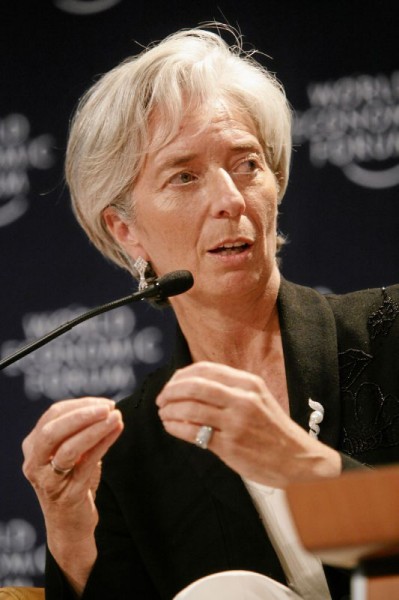 in North Africa and the Middle East. While this refugee crisis captures media attention in the advanced economies, it is by no means an isolated event. Conflicts are raging in many other parts of the world, too, and there are close to 60 million displaced people worldwide.
in North Africa and the Middle East. While this refugee crisis captures media attention in the advanced economies, it is by no means an isolated event. Conflicts are raging in many other parts of the world, too, and there are close to 60 million displaced people worldwide.
Let us also not forget that the year 2015 is on course to be the hottest year on record, with an extremely strong El Niño that has spawned weather-related calamities in the Pacific.
On the economic front, there is also reason to be concerned. The prospect of rising interest rates in the United States and China’s slowdown are contributing to uncertainty and higher market volatility. There has been a sharp deceleration in the growth of global trade. And the rapid drop in commodity prices is posing problems for resource-based economies.
Words such as these are bound to fuel an atmosphere of pessimism. Emerging economies are expected to see slowing economic growth for the fifth year in succession.  And financial stability is still not yet assured despite efforts to repair balance sheets following the financial crash of 2008/9.
And financial stability is still not yet assured despite efforts to repair balance sheets following the financial crash of 2008/9.
But as far as stock markets are concerned, the ECB is in the process of a massive quantitative easing programme, which will boost asset prices, and Japan looks as if it too will embark on a further round of QE. Interest rates remain very low, and, as we discussed in the blog Down down deeper and down, or a new Status Quo?, some central banks now have negative rates of interest. This makes shares relatively attractive for savers, so long as it is believed that they will rise over the medium term.
 Then there is the question of speculation. The falls were partly due to people anticipating that share prices would fall. But has this led to overshooting, with prices set to rise again? Or, will pessimism set in once more as people become even gloomier about the world economy? If only I had a crystal ball!
Then there is the question of speculation. The falls were partly due to people anticipating that share prices would fall. But has this led to overshooting, with prices set to rise again? Or, will pessimism set in once more as people become even gloomier about the world economy? If only I had a crystal ball!
Articles
Markets see their worst quarter in four years BBC News (1/10/15)
Weak Jobs Data Can’t Keep U.S. Stocks Down Wall Street Journal, Corrie Driebusch (2/10/15)
What the 3rd Quarter Tells Us About The Stock Market In October EFT Trends, Gary Gordon (2/10/15)
The bull market ahead: Why shares should make 6.7pc a year until 2025 The Telegraph, Kyle Caldwell (5/9/15)
Is the FTSE 100’s six year run at an end? The bull and bear points The Telegraph, Kyle Caldwell (24/8/15)
Webcasts
 The stock market bull may not be dead yet CNNMoney (29/9/15)
The stock market bull may not be dead yet CNNMoney (29/9/15)
 IMF’s Lagarde: More volatility likely for emerging markets CNBC, Everett Rosenfeld (30/9/15)
IMF’s Lagarde: More volatility likely for emerging markets CNBC, Everett Rosenfeld (30/9/15)
 What’s next for stocks after worst quarter in four year CNBC, Patti Domm (30/9/15)
What’s next for stocks after worst quarter in four year CNBC, Patti Domm (30/9/15)
 Global markets to log worst quarter since 2011 CNBC, Nyshka Chandran (30/9/15)
Global markets to log worst quarter since 2011 CNBC, Nyshka Chandran (30/9/15)
Speech
Managing the Transition to a Healthier Global Economy IMF, Christine Lagarde (30/9/15)
Questions
- Distinguish between stabilising and destabilising speculation. Is it typical over a period of time that you will get both? Explain.
- What is meant by a ‘dead cat bounce’? How would you set about identifying whether a given rally was such a phenomenon?
- Examine the relationship between the state (and anticipated state) of the global economy and share prices.
- What is meant by (a) the dividend yield on a share; (b) the price/earnings ratio of a share? Investigate what has been happening to dividend yields and price/earnings ratios over the past few months. What is the relationship between dividend yields and share prices?
- Distinguish between bull and bear markets.
- What factors are likely to drive share prices (a) higher; (b) lower?
- Is now the time for investors to buy shares?
 If you asked virtually any banker or economist a few years ago whether negative (nominal) interest rates were possible, the answer would almost certainly be no.
If you asked virtually any banker or economist a few years ago whether negative (nominal) interest rates were possible, the answer would almost certainly be no.
Negative real interest rates have been common at many points in time – whenever the rate of inflation exceeds the nominal rate of interest. People’s debts and savings are eroded by inflation as the interest due or earned does not keep pace with rising prices.
But negative nominal rates? Surely this could never happen? It was generally believed that zero (or slightly above zero) nominal rates represented a floor – ‘a zero lower bound’.
The reasoning was that if there were negative nominal rates on borrowing, you would effectively be paid by the bank to borrow.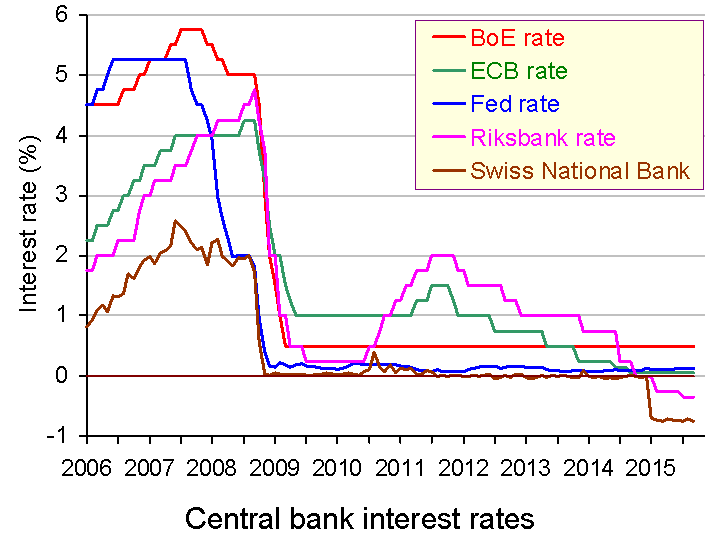 In such a case, you might as well borrow as much as you can, as you would owe less later and could pocket the difference.
In such a case, you might as well borrow as much as you can, as you would owe less later and could pocket the difference.
A similar argument was used with savings. If nominal rates were negative, savers might as well withdraw all their savings from bank accounts and hold them as cash (perhaps needing first to buy a safe!) Given, however, that this might be inconvenient and potentially costly, some people may be prepared to pay banks for looking after their savings.
Central bank interest rates have been hovering just above zero since the financial crisis of 2008. And now, some of the rates have turned negative (see chart above). The ECB has three official rates:
|
|
| • |
The interest rate on the main refinancing operations (MRO), which provide the bulk of liquidity to the banking system. |
| • |
The rate on the deposit facility, which banks may use to make overnight deposits with the Eurosystem. |
| • |
The rate on the marginal lending facility, which offers overnight credit to banks from the Eurosystem. |
The first of these is the most important rate and remains above zero – just. Since September 2014, it has been 0.05%. This rate is equivalent to the Bank of England’s Bank Rate (currently still 0.5%) and the Fed’s Federal Funds Rate (currently still between 0% and 0.25%).
The third of the ECB’s rates is currently 0.3%, but the second – the rate on overnight deposits in the ECB by banks in the eurozone – is currently –0.2%.  In other words, banks have to pay the ECB for making these overnight deposits (deposits that can be continuously rolled over). The idea has been to encourage banks to lend rather than simply keeping unused liquidity.
In other words, banks have to pay the ECB for making these overnight deposits (deposits that can be continuously rolled over). The idea has been to encourage banks to lend rather than simply keeping unused liquidity.
In Nordic countries, the experiment with negative rates has gone further. With plenty of slack in the Swedish economy, negative inflation and an appreciating krona, the Swedish central bank – the Riksbank – cut its rates below zero.
Many City analysts believe that the Riksbank will continue cutting, reducing its key interest rate to minus 0.5% by the end of the year [it is currently 0.35%]. Switzerland’s is already deeper still, at minus 0.75%, while Denmark and the eurozone have joined them as members of the negative zone.
But the nominal interest rate on holding cash is, by definition, zero. If deposit rates are pushed below zero, then will more and more people hold cash instead?  The hope is that negative nominal interest rates on bank accounts will encourage people to spend. It might, however, merely encourage them to hoard cash.
The hope is that negative nominal interest rates on bank accounts will encourage people to spend. It might, however, merely encourage them to hoard cash.
The article below from The Telegraph looks at some of the implications of an era of negative rates. The demand for holding cash has been increasing in many countries and, along with it, the supply of banknotes, as the chart in the article shows. Here negative interest are less effective. In Nordic countries, however, the use of cash is virtually disappearing. Here negative interest rates are likely to be more effective in boosting aggregate demand.
Article
How Sweden’s negative interest rates experiment has turned economics on its head The Telegraph, Peter Spence (27/9/15)
Data
Central bank and monetary authority websites Bank for International Settlements
Central banks – summary of current interest rates global-rates.com
Questions
- Distinguish between negative real and negative nominal interest rates.
- What is the opportunity cost of holding cash – the real or the nominal interest rate forgone by not holding it in a bank?
- Are there any dangers of central banks setting negative interest rates?
- Why may negative interest rates be more effective in Sweden than in the UK?
- ‘Andy Haldane, a member of the Monetary Policy Committee (MPC) … suggested that to achieve properly negative rates, the abolition of cash itself might be necessary.’ Why?
- Why does Switzerland have notes of SF1000 and the eurozone of €500? Should the UK have notes of £100 or even £500?
- Why do some banks charge zero interest rates on credit cards for a period of time to people who transfer their balances from another card? Is there any incentive for banks to cut interest rates on credit cards below zero?
 Is slower economic growth a cost of cutting greenhouse gas emissions? Apparently not – at least according to two studies: one by DIW Econ, a German institute for economic research, and the other, earlier this year, by the International Energy Association (see reports below).
Is slower economic growth a cost of cutting greenhouse gas emissions? Apparently not – at least according to two studies: one by DIW Econ, a German institute for economic research, and the other, earlier this year, by the International Energy Association (see reports below).
The IEA study found that, despite global GDP having grown by 6.4% in 2014, global emissions remained flat. The DIW Econ study found that from 2004 to 2014, OECD countries as a whole grew by 16% while cutting fossil fuel consumption by 6% and greenhouse gas emissions by 6.4%.
But what does this mean? If growth accelerated, what would happen to greenhouse gas emissions? Would they begin to rise again? Probably.
The point is that various developments, largely independent of economic growth have been reducing the greenhouse gas emissions/GDP ratio. These developments include: technological advances in energy generation; the switch to alternative fuels in many countries, thanks, in large part to lower renewable energy costs; increased energy efficiency by consumers; and a continuing move from energy-intensive manufacturing to less energy-intensive services.
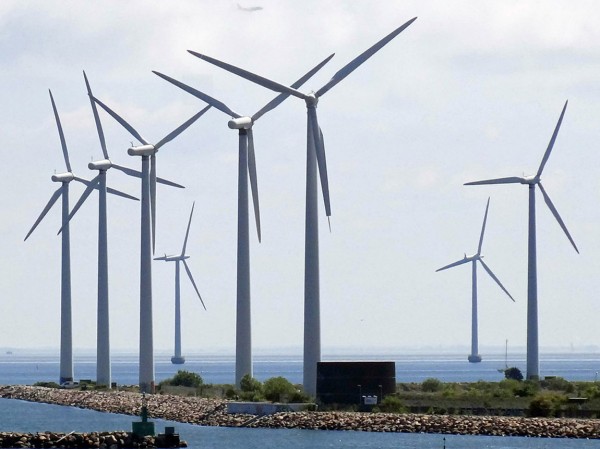 So if governments forced more radical cuts in greenhouse gases, would this reduce the rate of economic growth or have no effect? For a given level of technological advancement, the initial effect would probably be a reduction in economic growth. But to the extent that this encouraged further investment in renewables and energy saving, it might even stimulate economic growth over the longer term, especially if it helped to bring lower energy prices.
So if governments forced more radical cuts in greenhouse gases, would this reduce the rate of economic growth or have no effect? For a given level of technological advancement, the initial effect would probably be a reduction in economic growth. But to the extent that this encouraged further investment in renewables and energy saving, it might even stimulate economic growth over the longer term, especially if it helped to bring lower energy prices.
A big problem in decoupling economic growth from fossil fuel usage is that developing countries, which are taking a growing share of world manufacturing, are more heavily dependent on coal than most developed countries. But even here there seems to be some hope. China, the biggest manufacturer in the developing world, is rapidly increasing its use of renewables. As the IEA press release states:
In China, 2014 saw greater generation of electricity from renewable sources, such as hydropower, solar and wind, and less burning of coal.
If the world is to tackle global warming by making significant cuts in greenhouse gases, there must be a way for developing countries to continue growing while making less use of fossil fuels.
Article
Cutting greenhouse gas emissions won’t slow global economic growth — report The Guardian, Bruce Watson (26/9/15)
Reports
Turning point: Decoupling Greenhouse Gas Emissions from Economic Growth DIW Econ, Lars Handrich, Claudia Kemfert, Anselm Mattes, Ferdinand Pavel, Thure Traber (September 2015)
World Energy Outlook Special Report 2015: Energy and Climate Change International Energy Agency (June 2015)
Questions
- What are the possible causal relationships between cutting greenhouse gas emissions and the rate of economic growth?
- What incentive mechanisms can governments or other agencies adopt to encourage reductions in greenhouse gas emissions without reducing economic growth?
- Can a cap and trade system, such as the European Emissions Trading Scheme help to achieve a given level of emissions reduction at minimum cost to economic growth? Explain.
- How might the developed world support developing countries in moving to a low carbon technology?
- What factors lie behind the falling costs of renewable energy? Are these the same factors that lie behind the falling cost of oil?
- What political problems might hinder the greater production of renewable energy?
- How might an economist set about determining a socially optimal amount of fossil fuel production? What conceptual and philosophical problems might there be in agreeing what is meant by a social optimum?
 You’ll be familiar with these types of posts from me, which typically start with a comment like: ‘On my commute to work on …’. That’s one of the good things about a long drive – the interesting and informative discussions that you hear on the radio. This one is another interesting piece from BBC Radio 4, looking at a very topical issue, especially to those living in the South West and other rural areas in the UK.
You’ll be familiar with these types of posts from me, which typically start with a comment like: ‘On my commute to work on …’. That’s one of the good things about a long drive – the interesting and informative discussions that you hear on the radio. This one is another interesting piece from BBC Radio 4, looking at a very topical issue, especially to those living in the South West and other rural areas in the UK.
We have recently seen pictures of farmers protesting about the price of milk and in places like Somerset, the protest took a rather odd method, where farmers from across the region entered supermarkets and simply bought all of the milk, before giving it away. The issue is that dairy farming is no longer profitable, as the price that dairy farmers receive for each pint of milk is now lower than the cost of providing it. Thus, for each pint they make a loss.
There are many reasons that have contributed to this situation, including pressures imposed by customers demanding cheaper prices; pressures from supermarkets using their monopsony power to  force down the prices paid to farmers; and pressures from abroad. In the case of milk, we have a surplus and with a perishable product, i.e. one that cannot be stored, unlike wheat, this has contributed to falling prices. Data suggest that we are seeing approximately one farmer per day being forced to leave the indsutry.
force down the prices paid to farmers; and pressures from abroad. In the case of milk, we have a surplus and with a perishable product, i.e. one that cannot be stored, unlike wheat, this has contributed to falling prices. Data suggest that we are seeing approximately one farmer per day being forced to leave the indsutry.
This programme explores the current dairy farming crisis and draws some similarities with the wheat crisis that the UK experienced in the 1930s. The programme below is 30 minutes and provides some interesting insights on two important commodities and the economics behind the markets.
 Today’s crisis in dairy farming and the wheat crisis of the 1930s BBC Radio 4; The Long View, Jonathan Freedland (29/9/15)
Today’s crisis in dairy farming and the wheat crisis of the 1930s BBC Radio 4; The Long View, Jonathan Freedland (29/9/15)
Questions
- Using demand and supply analysis, explain the situation in the milk market.
- Now consider the wheat industry and provide a similar analysis of how prices are set and what caused the problems seen in the 1930s.
- Although these two commodities have similarities they are also very different. Why can two different commodities experience such similar problems at such different times?
- What are the key demand and supply-side factors affecting the current low price of milk?
- Consider the market for (a) milk and (b) wheat. What are (if any) the market failures within each area?
- Agriculture is an area where we do see significant government intervention. Should the UK government be doing more to help the UK’s dairy farmers? If so, what should they do and would this intervention create further problems, e.g. unintended consequences?
 The International Monetary Fund has just published its six-monthly World Economic Outlook (WEO). The publication assesses the state of the global economy and forecasts economic growth and other indicators over the next few years. So what is this latest edition predicting?
The International Monetary Fund has just published its six-monthly World Economic Outlook (WEO). The publication assesses the state of the global economy and forecasts economic growth and other indicators over the next few years. So what is this latest edition predicting? To achieve faster economic growth in the longer term, potential national output must grow more rapidly. This can be achieved by a combination of more rapid technological progress and higher investment in both physical and human capital. But in the short term, aggregate demand must expand sufficiently rapidly. Higher short-term growth will encourage higher investment, which in turn will encourage faster growth in potential national output.
To achieve faster economic growth in the longer term, potential national output must grow more rapidly. This can be achieved by a combination of more rapid technological progress and higher investment in both physical and human capital. But in the short term, aggregate demand must expand sufficiently rapidly. Higher short-term growth will encourage higher investment, which in turn will encourage faster growth in potential national output.Persistently low investment helps explain limited labour productivity and wage gains, although the joint productivity of all factors of production, not just labour, has also been slow. Low aggregate demand is one factor that discourages investment, as the last World Economic Outlook report showed. Slow expected potential growth itself dampens aggregate demand, further limiting investment, in a vicious circle.
 Global Growth Slows Further, IMF’s latest World Economic Outlook IMF Podcast, Maurice Obstfeld (6/10/15)
Global Growth Slows Further, IMF’s latest World Economic Outlook IMF Podcast, Maurice Obstfeld (6/10/15)














